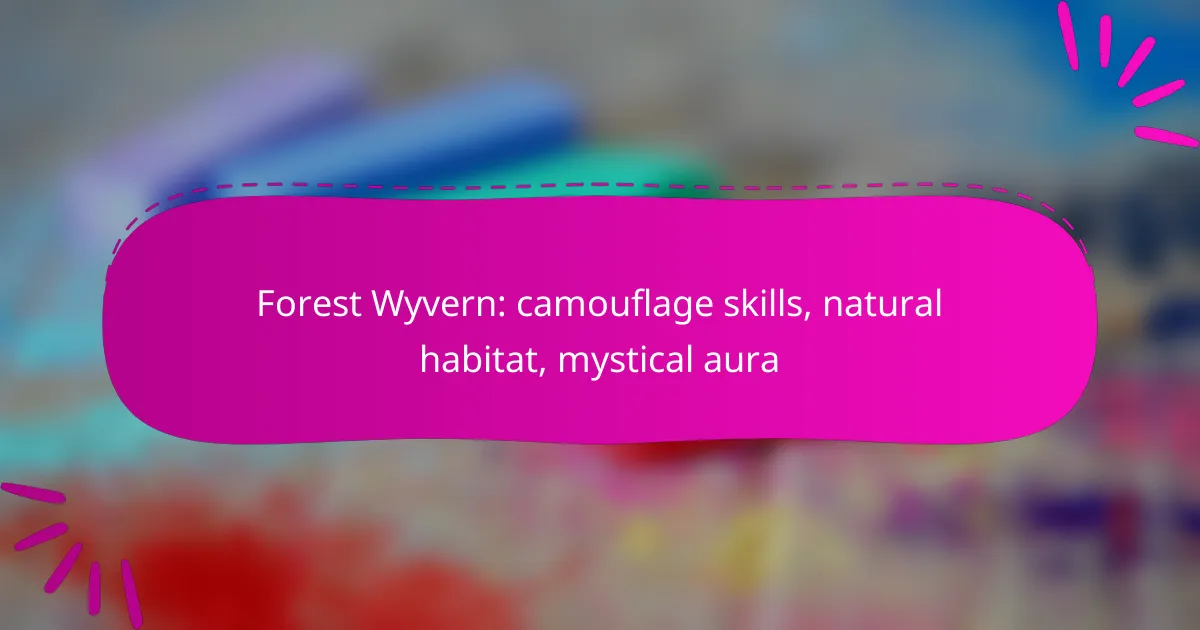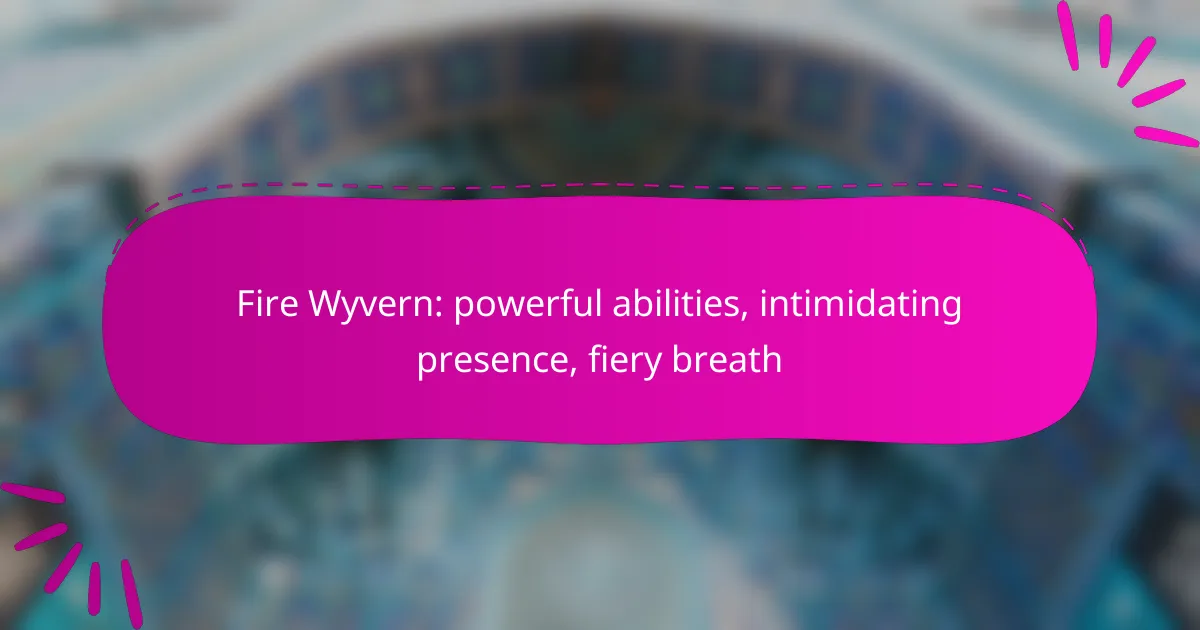The Shadow Wyvern is a master of stealth, utilizing its dark coloration and silent flight to remain undetected in its nocturnal habitat. Active primarily at night, this creature employs specialized adaptations that enhance its hunting efficiency and ambush tactics, making it a formidable predator in low-light conditions.

How does the Shadow Wyvern utilize stealth abilities?
The Shadow Wyvern employs stealth abilities primarily through its dark coloration, silent flight techniques, and behavioral adaptations for ambush. These traits enable it to remain undetected while hunting or evading threats in its nocturnal environment.
Camouflage through dark coloration
The Shadow Wyvern’s dark coloration allows it to blend seamlessly into its surroundings, particularly during nighttime. This adaptation helps it avoid detection by both prey and predators, as it can merge with shadows and dark landscapes.
Typically, the wyvern’s scales exhibit a range of deep blacks and dark grays, which can absorb light rather than reflect it. This coloration is especially effective in forested areas or rocky terrains where shadows are prevalent.
Silent flight techniques
To maintain stealth during flight, the Shadow Wyvern utilizes specialized wing structures that minimize noise. Its wings are designed with a serrated edge that reduces turbulence, allowing for near-silent movement through the air.
This silent flight is crucial for stalking prey, as it enables the wyvern to approach without alerting its target. The combination of slow, gliding motions and careful wing adjustments enhances its ability to remain undetected.
Behavioral adaptations for ambush
The Shadow Wyvern exhibits specific behaviors that enhance its ambush capabilities. It often perches in high, concealed locations, waiting patiently for the right moment to strike.
Additionally, it employs a strategy of remaining motionless for extended periods, allowing it to blend into the environment. This patience, combined with its stealthy approach, increases the likelihood of a successful hunt.

What are the key characteristics of the Shadow Wyvern’s dark coloration?
The Shadow Wyvern’s dark coloration primarily serves as a form of camouflage, allowing it to blend seamlessly into its nocturnal surroundings. This adaptation enhances its stealth abilities, making it an effective predator during the night.
Melanin-rich skin for light absorption
The skin of the Shadow Wyvern is rich in melanin, which absorbs light rather than reflecting it. This characteristic allows the wyvern to remain nearly invisible in low-light conditions, effectively hiding from both prey and potential threats. The high melanin content not only aids in stealth but also provides some protection against UV radiation.
In practical terms, this means that the Shadow Wyvern can navigate through dark environments without drawing attention, making it a formidable hunter. The dark coloration can vary slightly among individuals, but the overall melanin-rich skin remains a defining feature.
Adaptive color changes in different environments
While the Shadow Wyvern is predominantly dark, it possesses the ability to adapt its coloration based on its surroundings. This adaptive camouflage allows it to blend into various environments, from shadowy forests to rocky terrains. Such flexibility enhances its stealth capabilities and increases its chances of successful hunting.
For example, when resting on dark rocks, the wyvern may appear even darker, while in a forested area, it can take on a slightly mottled appearance to match the dappled light. This adaptability is crucial for survival, enabling the Shadow Wyvern to thrive in diverse habitats.
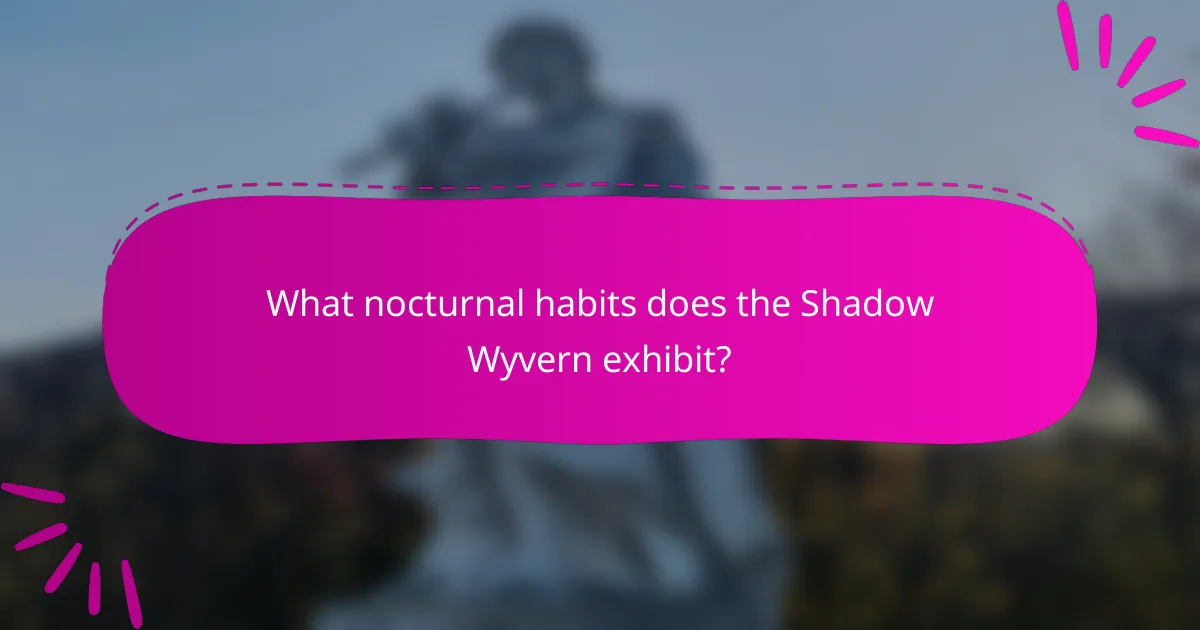
What nocturnal habits does the Shadow Wyvern exhibit?
The Shadow Wyvern is primarily active during the night, showcasing behaviors that enhance its stealth and hunting efficiency in low-light conditions. Its dark coloration and specialized adaptations allow it to thrive in the darkness, making it a formidable nocturnal predator.
Active hunting during nighttime
The Shadow Wyvern engages in active hunting at night, leveraging its dark coloration to blend seamlessly into the shadows. This camouflage allows it to approach prey without being detected, increasing its chances of a successful hunt.
During nighttime, the wyvern typically targets smaller creatures, which are more vulnerable in the dark. Its hunting strategy often involves stealthy movements and sudden bursts of speed to catch unsuspecting prey.
Use of echolocation for navigation
To navigate effectively in the dark, the Shadow Wyvern utilizes echolocation, emitting sound waves that bounce off objects and return to it. This ability allows the wyvern to create a mental map of its surroundings, identifying obstacles and potential prey even in complete darkness.
Echolocation is particularly beneficial in dense environments, such as forests or caves, where visibility is limited. By relying on this skill, the Shadow Wyvern can move confidently and maintain its stealth while hunting at night.
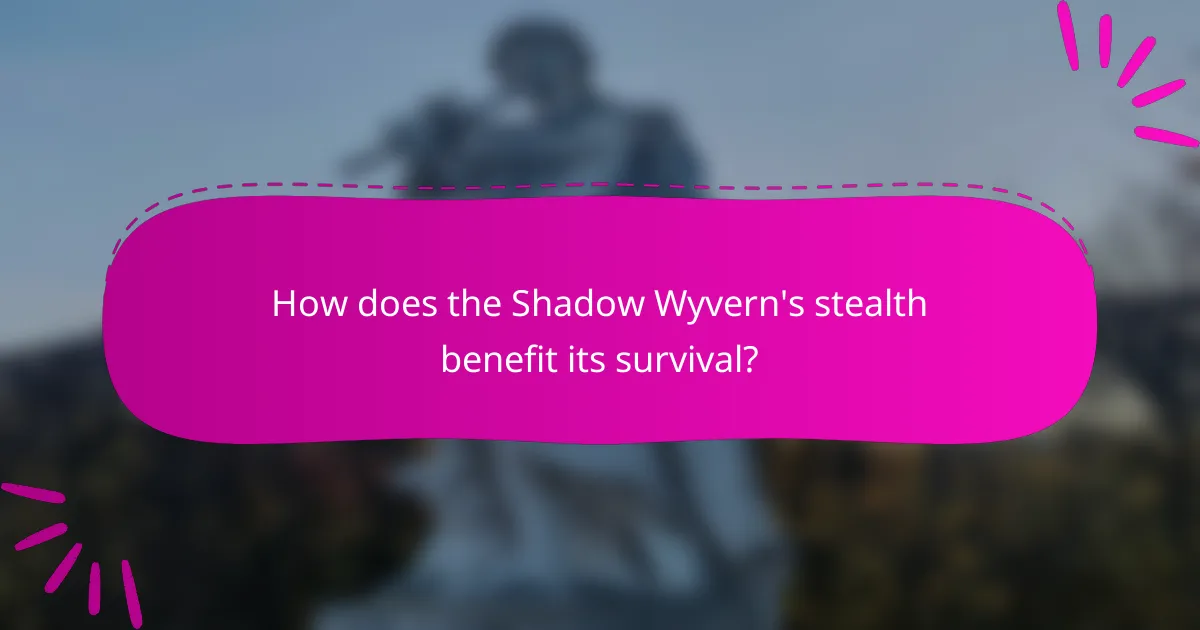
How does the Shadow Wyvern’s stealth benefit its survival?
The Shadow Wyvern’s stealth is crucial for its survival, allowing it to evade predators and enhance its hunting capabilities. This creature’s dark coloration and nocturnal habits work together to create an effective camouflage in its natural habitat, providing significant advantages in both avoidance and predation.
Avoidance of predators
The Shadow Wyvern’s ability to remain undetected is vital for avoiding larger predators. Its dark coloration blends seamlessly into the night sky and dense foliage, making it difficult for threats to spot it. By utilizing stealth, the Wyvern can stay hidden until danger passes, reducing the risk of confrontation.
Additionally, the Wyvern’s nocturnal habits mean it is most active when many predators are less alert. This behavior allows it to navigate its environment with minimal risk, as it can take advantage of the cover of darkness to escape potential threats.
Increased hunting success rates
Stealth significantly boosts the Shadow Wyvern’s hunting success rates by allowing it to approach prey without being detected. The Wyvern can quietly stalk its target, using its dark coloration to remain concealed until the perfect moment to strike. This strategy increases the likelihood of a successful capture.
Moreover, the element of surprise is a key factor in its hunting technique. By remaining hidden and then launching a sudden attack, the Wyvern can catch its prey off guard, often resulting in a swift and efficient hunt. This method not only conserves energy but also maximizes the chances of securing food in a competitive environment.
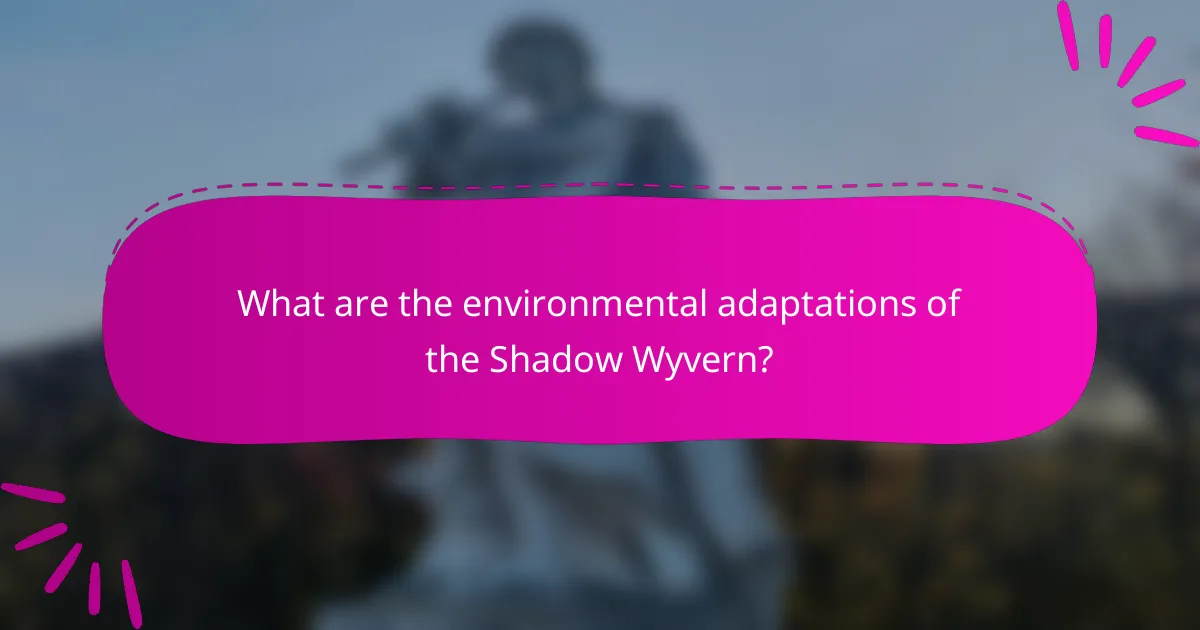
What are the environmental adaptations of the Shadow Wyvern?
The Shadow Wyvern has evolved several environmental adaptations that enhance its stealth and hunting capabilities. Key features include its dark coloration, which provides camouflage in low-light conditions, and its nocturnal habits that align with its predatory lifestyle.
Habitat preferences in dense forests
The Shadow Wyvern thrives in dense forests where the thick canopy provides ample cover. These environments allow it to blend seamlessly into the shadows, making it difficult for both prey and predators to detect it. The underbrush offers additional hiding spots, enhancing its stealth during hunts.
Typically, these wyverns prefer areas with a mix of tall trees and dense foliage, as this combination maximizes their ability to remain unseen. They are often found near water sources, which are crucial for hydration and hunting aquatic prey.
Temperature regulation during night hunts
During night hunts, the Shadow Wyvern employs various strategies for temperature regulation. Its dark coloration not only aids in camouflage but also helps absorb heat from the environment, allowing it to maintain optimal body temperature while active at night.
Additionally, the wyvern’s physiology is adapted to conserve energy during cooler nighttime temperatures. It can reduce its metabolic rate when necessary, ensuring that it remains agile and effective during its nocturnal activities without overheating.
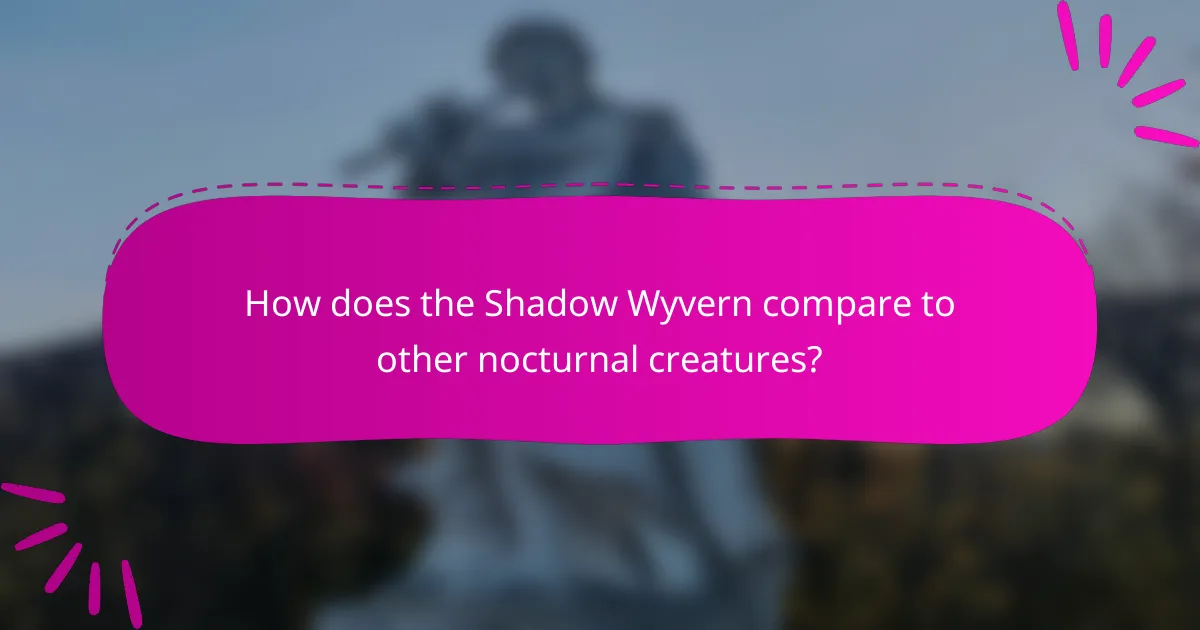
How does the Shadow Wyvern compare to other nocturnal creatures?
The Shadow Wyvern stands out among nocturnal creatures due to its unique combination of stealth abilities, dark coloration, and specialized hunting techniques. Unlike many other nighttime predators, it employs a blend of camouflage and acute sensory perception to navigate and hunt effectively in low-light environments.
Comparison with owls in hunting strategies
Both the Shadow Wyvern and owls are adept hunters in the dark, but they utilize different strategies. Owls rely heavily on their exceptional hearing and silent flight to locate and capture prey, often swooping down from above. In contrast, the Shadow Wyvern combines its ability to blend into the shadows with keen eyesight, allowing it to stalk prey more stealthily on the ground.
While owls may hunt primarily small mammals and insects, the Shadow Wyvern’s diet can include larger prey, leveraging its size and strength. This difference in prey selection reflects their distinct ecological niches within the nocturnal environment.
Differences from other dragon species
The Shadow Wyvern differs significantly from other dragon species, particularly in its adaptations for nocturnal life. Many dragons are known for their vibrant scales and powerful fire-breathing abilities, which are less suited for stealth. In contrast, the Shadow Wyvern’s dark coloration provides excellent camouflage in the night, making it less visible to both prey and potential threats.
Additionally, while other dragons may exhibit more aggressive and territorial behaviors, the Shadow Wyvern tends to be more elusive and solitary, preferring to hunt and roam in silence. This behavioral trait enhances its survival in environments where stealth is crucial.
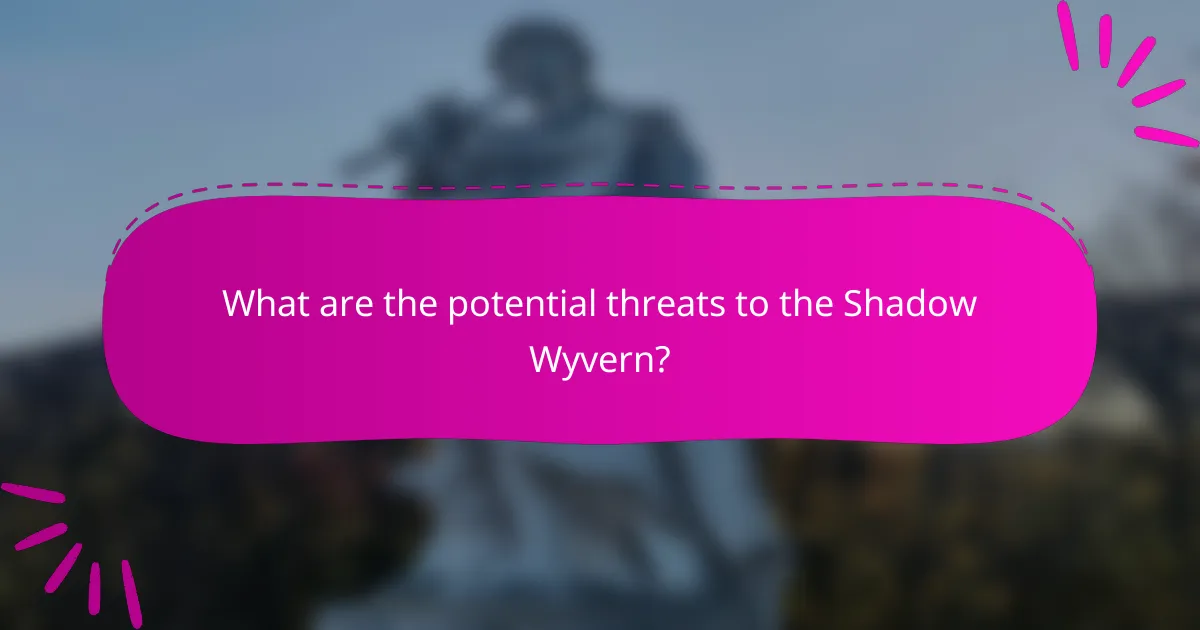
What are the potential threats to the Shadow Wyvern?
The Shadow Wyvern faces several potential threats that can impact its survival, primarily habitat loss and changes in its nocturnal behavior. These threats stem from human activities and environmental changes that disrupt its natural ecosystem.
Habitat loss due to urbanization
Urbanization poses a significant threat to the Shadow Wyvern by encroaching on its natural habitats. As cities expand, forests and wetlands are often cleared, leading to a reduction in available nesting and hunting grounds.
This habitat loss can fragment populations, making it difficult for the Shadow Wyvern to find mates and food. Conservation efforts should focus on protecting existing habitats and restoring areas that have been degraded.
Climate change impacts on nocturnal behavior
Climate change affects the Shadow Wyvern’s nocturnal habits by altering temperature and weather patterns, which can disrupt its hunting and breeding cycles. Warmer nights may lead to increased activity levels, affecting its stealth and hunting efficiency.
Additionally, changes in prey availability due to climate shifts can force the Shadow Wyvern to adapt its hunting strategies. Monitoring these changes is crucial for developing effective conservation strategies that ensure the survival of this species in a changing environment.
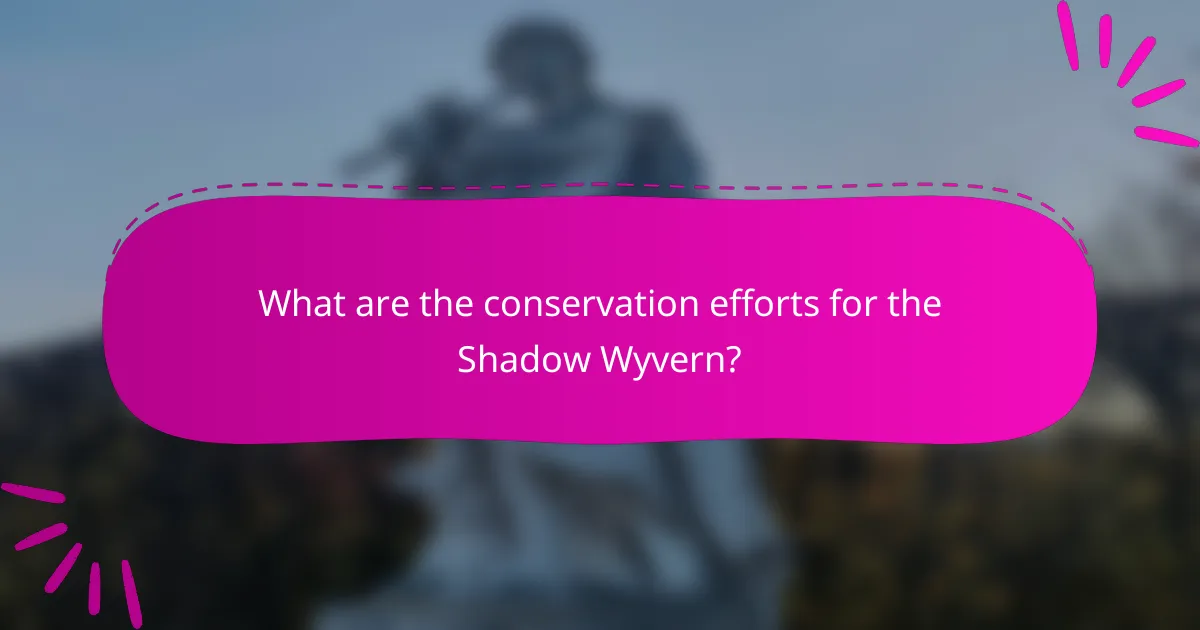
What are the conservation efforts for the Shadow Wyvern?
Conservation efforts for the Shadow Wyvern focus on habitat preservation, breeding programs, and legal protections to ensure their survival. These initiatives aim to mitigate threats from habitat loss and illegal hunting.
Habitat Preservation
Preserving the natural habitats of the Shadow Wyvern is crucial for their conservation. Efforts include establishing protected areas and restoring degraded environments to support their nocturnal lifestyle. Conservation organizations often collaborate with local communities to promote sustainable land use practices.
Breeding Programs
Breeding programs are essential for increasing the population of Shadow Wyverns in captivity and reintroducing them into the wild. These programs typically involve genetic research to ensure diversity and health among the breeding stock. Successful breeding can help bolster dwindling populations and enhance genetic resilience.
Legal Protections
Legal protections for the Shadow Wyvern include regulations against poaching and trade. Many countries have implemented laws that classify the species as endangered, making it illegal to hunt or capture them without permits. Enforcement of these laws is vital to deter illegal activities that threaten their survival.







